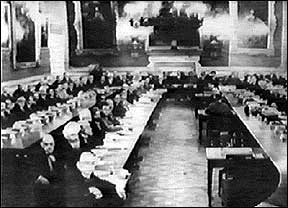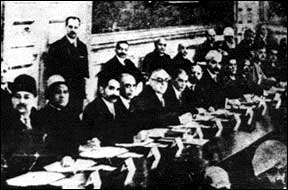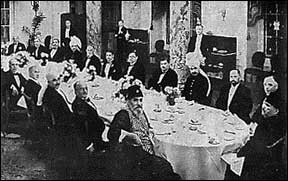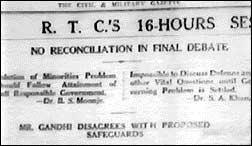 |
The First Round Table Conference was held in London, 1930
|
The report of the Simon Commission issued in June 1930 - was received with great resentment and the Indian political parties reacted in different ways. In resentment, the Congress started a Civil Disobedience Movement under Gandhi’s command.
The Muslims reserved their opinion on the Simon Report and declared that this report was not final and the matters would be finally decided after consultations with the leaders representing all communities in India.
The Indian political situation seemed deadlocked. The British government refused to contemplate any form of self-government for the people of India who were frustrated and often expressed their anger in violent clashes.
However, in 1931, Labour government returned to power in Britain, and a glimmer of hope ran through Indian hearts. Labour leaders had always been sympathetic to the Indian cause. The Labour Government decided to hold a Round Table Conference in London, to consider new constitutional reforms. All the Indian politicians, Hindus, Muslims, Sikhs and Christians were summoned to London for the conference.
Gandhi immediately insisted at the conference that he alone spoke for all Indians, and that the Congress was the party of the people of India. He argued that the other parties only represented sectarian viewpoints, with little or no significant following.
 |
At the Round Table Conference held in London, 1930 (from left to right): Sardar Aurangzeb, A. K. Fazlul Haq, Nawab Chhatari, Mian Muhammad Shafi, The Aga Khan, Quaid-i-Azam Muhammad Ali Jinnah, Sir Muhammad Zafarullah Khan, Sahebzada Abdul Qayyum and Sir Ghulam Hussain Hidayatullah
|
First Round Table Conference
The first session of the conference opened in London on November 12, 1930. All parties were present except for the Congress, whose leaders were in jail due to the Civil Disobedience Movement. Congress leaders stated that they had nothing to do with further constitutional discussion unless the Nehru report was enforced in it’s entirety as the constitution of India.
The first session of the conference opened in London on November 12, 1930. All parties were present except for the Congress, whose leaders were in jail due to the Civil Disobedience Movement. Congress leaders stated that they had nothing to do with further constitutional discussion unless the Nehru report was enforced in it’s entirety as the constitution of India.
Almost eighty-nine members attended the conference, out of which fifty-eight were chosen from various communities and interests in British India, and the rest from princely states and other political parties. The prominent among the Muslim delegates invited by the British government were Sir Aga Khan, Quaid-i-Azam, Maulana Mohammad Ali Johar, Sir Mohammad Shafi and Maluvi Fazl-i-Haq. Sir Taj Bahadur Sapru, Mr. Jaikar and Dr. Moonje were outstanding among the Hindu leaders.
The Hindu- Muslim differences overcast the conference as the Hindus were for a powerful Central government while the Muslims stood for a loose federation of completely autonomous province. The Muslims demanded maintenance of weightage and separate electorates, the Hindus their abolition. The Muslims claimed statutory majority in Punjab and Bengal, while Hindus resisted their imposition. In Punjab, the situation was complicated by inflated Sikh claims.
The Conference dealt with the details through eight sub-committees on federal structure, provincial constitution, franchise, Sind, the North-West Frontier Province, defense services and minorities.
The conference broke up on January 19, 1931, and what emerged from it was a general agreement to write safeguards for minorities into the constitution and a vague desire to devise a federal system for the country.
 |
Seated participants at the Second Round Table Conference
|
Second Round Table Conference
The second session of the conference opened in London on September 7, 1931. The main task of the conference was done through the two committees on federal structure and minorities. Gandhi was a member of both but he adopted a very unreasonable attitude. He claimed that he represented all India and dismissed all other Indian delegates as non-representative because they did not belong to the Congress.
The second session of the conference opened in London on September 7, 1931. The main task of the conference was done through the two committees on federal structure and minorities. Gandhi was a member of both but he adopted a very unreasonable attitude. He claimed that he represented all India and dismissed all other Indian delegates as non-representative because they did not belong to the Congress.
The communal problem represented the most difficult issue to the delegates. Gandhi again tabled the Congress scheme for a settlement, a mere reproduction of the Nehru report, but it was rejected by all the minorities.
As a counter to the Congress scheme the Muslims, the depressed classes, the Indian Christians, the Anglo-Indians and the European presented a joint statement of claims which they said must stand as an interdependent whole. As their main demands were not acceptable to Gandhi, the communal issue was postponed for future discussion.
On the concluding day, the British Prime Minister, Ramsay Macdonald appealed to the Indian leaders to reach a communal settlement. Failing to do so, the British government would take a unilateral decision.
Quaid-i-Azam did not participate in the session of the second Round Table Conference as he decided to keep himself aloof from the Indian politics and to practice as a professional lawyer in England.
On his return to India, Gandhi once again started civil disobedience movement and was duly arrested. Three important committees drafted their reports: The Franchise Committee, the Federal Finance Committee and States Inquiry Committee.
 |
A news clip reporting the Third Round Table Conference
|
Third Round Table Conference
The third session began on November 17, 1932, was short and unimportant. The Congress was once again absent, so was the Labour opposition in the British parliament. Reports of the various committees were scrutinized and ended on December 25, 1932.
The third session began on November 17, 1932, was short and unimportant. The Congress was once again absent, so was the Labour opposition in the British parliament. Reports of the various committees were scrutinized and ended on December 25, 1932.
The recommendations of the Round Table Conferences were embodied in a White Paper. It was published in March 1933, and debated in Parliament directly afterwards, analyzed by the Joint Select Committee and after the final reading and the loyal assent,

No comments:
Post a Comment